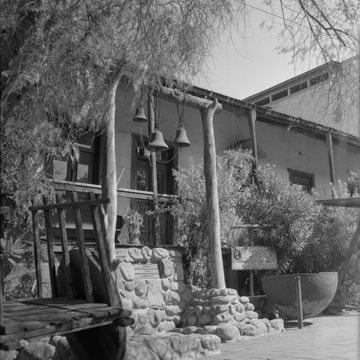Constructed during the last few years of the Spanish era in California, the Avila Adobe is the oldest standing residence in Los Angeles. It was built by Francisco Avila, an early mayor of Los Angeles, and was considered one of the finest in Southern California at the time of its completion. The structure sits on Olvera Street, now part of the Los Angeles Plaza Historic District.
The Avila Adobe was originally built as a large, L-shaped structure with a compacted earthen floor and fifteen-foot ceilings composed of cottonwood beams from the hundreds of trees that grew along the nearby Los Angeles River. The most notable characteristic of the residence is the thick walls made from sunbaked adobe bricks. Measuring almost three feet thick, this design element was highly effective for temperature regulation, keeping the space cooler in the summer and warmer in the winter. The beams of the original roof were sealed with tar that was brought over from the La Brea Tar Pits about eight miles southwest. Wealthy cattle rancher Avila was the grantee of Rancho Las Cienegas and the Tar Pits were located near the northern boundary of his land grant.
The house was where Avila would entertain business associates, patrons, family, and friends on weekends, special holidays, and various festivals throughout the year. The site was opulent in its day, with the rear of the house including a long porch that overlooked a patio, vineyard, and garden. Avila later added a wooden veranda and steps to the front of the building. The house included a family room, office, living room, sleeping quarters, and a kitchen, although cooking was done in the rear courtyard. Many of the rooms were furnished with imported items from Asia, Europe, Mexico, and New England. Besides French doors and window frames from Boston, Avila acquired an assortment of eclectic household goods from traveling merchant ships that stopped in San Pedro Bay and transported inland by ox-drawn carts.
Avila was considered among the wealthiest of the Californio cattle ranchers and his house demonstrated this. “Californio” was the term used for the Mexican cattle ranchers and prominent families of Mexican descent throughout the state during the nineteenth century. The names of these Californio families remain on many of the streets across Southern California, with Pio Pico, the namesake of Pico Boulevard and the last Mexican governor of California, perhaps being the best known example. Though Avila died in 1832, his widow resided at the house until her death in 1855. American troops temporarily occupied the residence during the Mexican-American War in January 1847. Avila’s youngest daughter lived in the house until 1868, and various family members occupied over the next few years before it became a boarding house. Following an 1870 earthquake, the building began to deteriorate.
In 1928, the City of Los Angeles condemned the structure. By that time, the entire Pueblo District had become rundown. If it were not for the efforts of Christine Sterling, an ambitious socialite from England by way of San Francisco, the Avila Adobe most likely would have been demolished. Sterling had arrived in Los Angeles during the 1920s and wanted to transform the derelict plaza area into a cultural and historic district honoring the city’s early history. Sterling mobilized civic leaders and Los Angeles Times owner and publisher Harry Chandler to support to her campaign to restore both the Pueblo District and the Avila Adobe itself. The Times ran several articles on the area’s history and Sterling’s restoration plans, inspiring the public, including descendants from Californio families like the Sepulvedas, to contribute funds and furnishings to make the transformation possible.
Sterling’s mission proved to be so successful that by 1930, the Olvera Street Plaza had been transformed into a Mexican-style marketplace and the Avila Adobe had been renovated into a residence for Sterling, who opened her house for tours. The State of California bought the house in 1953 as part of the El Pueblo de Los Angeles State Historic Park, although Sterling remained in residence until her death in 1963.
Though some historians like Carey McWilliams and Eric Avila have argued that the Los Angeles Plaza Historic District celebrates a fantasy Spanish heritage, the area remains significant as the birthplace of the city, regardless of the manufactured nature of some of the surrounding streetscape.
The Avila Adobe stands as a relic to the early history of Los Angeles. It underwent another renovation following the 1971 Sylmar earthquake. The house has been reduced in size over the years, with seven of the original rooms remaining. Later changes to the structure also included the installation of plank flooring. The Avila Adobe has been open to the public for tours since 1976.
References
Carrillo, Leo. The California I Love. Englewood Cliffs, NJ: Prentice-Hall, 1962.
Estrada, William D. “Los Angeles’ Old Plaza and Olvera Street: Imagined and Contested Space.” Western Folklore53, no. 2 (Winter 1999): 107-129.
Estrada, William D. Los Angeles’s Olvera Street. Charleston, SC: Arcadia Publishing, 2006.
Kropp, Phoebe S. “Citizens of the Past? Olvera Street and the Construction of Race and Memory in 1930s Los Angeles.” Radical History Review81 (Fall 2001): 35-60.
Marinacci, Barbara and Rudy. California's Spanish Place Names. Santa Monica, CA: Angel City Press, 2005.
Moore, Charles, et al. Los Angeles: The City Observed. Los Angeles: Hennessey and Ingalls, 1984.
Poole, Jean Bruce and Tevvy Ball. El Pueblo: the Historic Heart of Los Angeles. Los Angeles: Getty Conservation Institute and the J. Paul Getty Museum, 2002.

